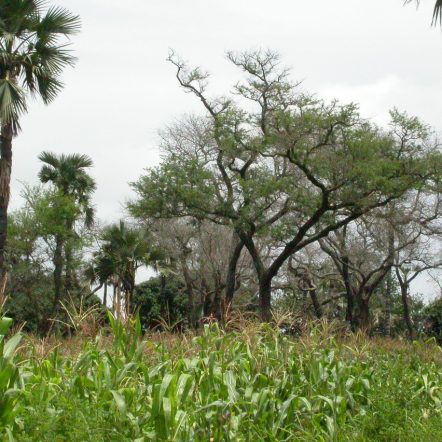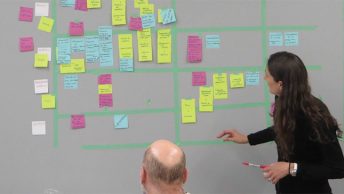Marcia Fajardo Cavalcanti de Albuquerque
Abstract
Agroforestry is the result of a dialectical relationship between humans and the environment, capable of increasing agricultural biodiversity. In the Brazilian Amazon region, Agroforestry Indigenous Agents have been disseminating these practices through participatory processes. They combine traditional knowledge and new techniques and technologies in order to ensure food security, improve environmental conservation, and guarantee a good quality of life. They promote behavior change towards more sustainable land management practices through knowledge sharing.
Introduction
Agrobiodiversity cannot be dissociated from cultural diversity. Agriculture is a means of social affirmation, the result of a relationship of integration and exchange between humans and the environment. The protection of agricultural biodiversity implies not only the protection of the environment but also the protection of traditional knowledge and customs, the ways of life of indigenous peoples and small farmers. Agricultural biodiversity and cultural diversity are interdependent and, according to Klaus Töpfer (UNESCO and UNEP 2003), there is a strong correlation between areas of maximum biodiversity and areas of cultural diversity. Agricultural biodiversity is the result of the complex and dynamic management of agricultural crops by farmers.
Agriculture forms part of the foundation of many human communities and no other human activity has caused as many positive and negative impacts on our planet and for the people inhabiting it. The management of agricultural biodiversity made by humans has multiple benefits, such as the balance of diverse crops in different agroecosystems, the conservation of cultural and traditional values, and the conservation of local varieties, which is an important element of stress resistance and adaptation to different climates and environments (Machado, Santilli and Magalhães 2008). Nevertheless, the agricultural sector is one of the largest contributors to greenhouse gas emissions and biodiversity loss.
The aim of this paper is to demonstrate that agroforestry practices are able to enhance agriculture’s positive outcomes through sustainable land management. However, agroforestry systems encompass complex practices and, if not managed correctly, they may not fulfill its potential of sustainability and climate change mitigation. They could be constrained by lack of information and technical assistance, such as capacity building, extension, and research programmes. This paper also shows that, in order to overcome these obstacles, Agroforestry Indigenous Agents are generating behavioral change and promoting environmental protection through culturally founded participatory and educational processes.
This work will be divided into three sections. The first section will consider agroforestry systems as the result of a dialectical relationship between humans and nature, the second section will examine the role of the Agroforestry Indigenous Agents in knowledge sharing, and the third section will analyze the important contribution of the Agroforestry Indigenous Agents to the socioenvironmental management of Indigenous territories.
The agroforestry systems as the result of a dialectical relationship between humans and nature
According to a general definition given by the World Agroforestry Center, agroforestry is
a collective name for all land-use systems and practices in which woody perennials are deliberately grown at the same land management unit as crops and/or animals. This can be either in some form of spatial arrangement or in a time sequence. To qualify as agroforestry, a given land-use system or practice must permit significant economic and ecological interactions between the woody and non woody components (Clarke and Thaman 1993: 9).
King and Chandler complement this definition, stating that agroforestry is “a sustainable land management system which increases the overall yield of the land, combines the production of crops (including tree crops) and forest plants and/or animals simultaneously or sequentially, on the same unit of land, and applies management practices that are compatible with the cultural practices of the local population” (1978: 2).
Agroforestry practices are based on a relationship of continuity, integration, and support between humans and nature. Rather than manipulating technology to reach maximum output, as seen in conventional agriculture, humans try to reproduce the dynamics of nature in order to optimize production and meet a wide range of economic and social needs (Ewert 2014). This makes sustainability an intrinsic characteristic of the agroforestry system. The alternation of production during the year ensures greater profits per acreage unit and greater economic stability since the earnings of certain seasonal products are balanced by others, reducing market risks for the farmer (Müller 2006). Moreover, agroforestry holds an important ecological role, since agroforestry systems provide several environmental services such as erosion control, retention of organic matter and improvement of the physical and chemical structure of the soil, an increase of nitrogen fixation and the promotion of efficient nutrient cycling, maintenance of biodiversity at levels similar to natural ecosystems, agrobiodiversity increase, and the capacity to recover and rehabilitate degraded land (Müller 2006).
Agroforestry systems tend to sequester much greater quantities of carbon than agricultural systems without trees, once they store carbon both in vegetation and in soils. Agroforestry can contribute to climate change mitigation through enhanced carbon sequestration, and micro-climate and macro-climate improvement. It also contributes to climate change adaptation, once the presence of trees in agricultural fields improves resilience to natural hazards, reduces vulnerability, diversifies production and income sources, and improves livelihoods, building the capacity of smallholders to adapt to climate change (Uthappa et al. 2017). Thus, it is considered a climate-smart agriculture technique.
From a social point of view, agroforestry systems can be seen as the result of a historical, individual, and collective path of a dialectical relationship between humans and the environment. Agroforestry has emerged from traditional and cultural practices that bind humans and nature. New techniques and practices of environmental management have been created through the information on ecosystems and plants obtained during this trajectory, which have been culturally transmitted. The transformation of the farmer’s relationship with natural resources generates a behavior change towards more sustainable practices (Vivan 2011). Agroforestry practices are able to maintain the population in rural areas, as it requires a constant workforce throughout the year, promoting sustainable diversification of production, food security, and good quality of life (Paludo and Costabeber 2012).
Clarke and Thaman explain that there are two different approaches to agroforestry: the institutional approach, which relies on modern agronomic science and field experimentation; and the traditional or indigenous approach, which emerged from “cultural geography and ecological anthropology” (1993). In Brazil, within this traditional approach, the Agroforestry Indigenous Agents are important agroforestry disseminators in the Amazon region. Belonging to different Indigenous ethnicities from Acre state, they have been chosen from each village to help implement agroforestry practices within Indigenous territories based on their own traditional practices (Gavazzi 2012: 32).
According to Bianchini, Indigenous agroforestry practices are based on three types of systems that present great agrobiodiversity:
- Agroforestry home gardens: cultivation of fruit trees and other useful plants;
- Agroforestry in capoeira (a term originating in the Tupi language): agroforestry practices implemented by the Indigenous Agroforestry Agents in secondary vegetation composed of sparse grasses and shrubs;
- Swidden–fallow agroforestry: (one-year community farmlands) cutting and firing of capoeira for farming, with subsequent enrichment with useful plants, such as fruit trees (Bianchini 2006).
Miller and Ramachandran Nair affirm that Indigenous agroforestry systems in the Amazon generate great knowledge on the interaction of plants and their environment and between agricultural, social, and cosmological systems (2006: 158)
In the Brazilian Amazon, agroforestry is attracting increasing attention of local communities and governmental institutions. Nevertheless, Miller and Ramachandran Nair argue that “the current configuration of extension services has, however, been unable to meet the demand for technical assistance” (2006: 162). Against such a scenario, the Agroforestry Indigenous Agents can represent important actors in the agroforestry knowledge sharing, as it will be analyzed by the next section.
Agroforestry Indigenous Agents as knowledge sharers
From the 1970s, Indigenous scholar education projects started to appear in the Brazilian Amazon region. The first Indigenous teachers were trained through a process of appropriation and re-signification of school education by Indigenous peoples. Concerning governments action, the education department of Acre state have been implementing indigenous teacher’s training programs (Bianchini 2006).
Acre State Pro Indigenous Commission (CPI-Acre) was created in 1979 to support Acre’s Indigenous peoples in the fight for land, education, health, and environmental protection through information and participation processes. CPI-Acre also promotes the professionalization of Indigenous adults based on the autodetermination principle, where the teaching material is elaborated by the Indigenous peoples themselves (Bianchini 2006). In 1983, the first teacher training course for Indigenous health agents was completed (Bianchini 2006).
In 1996, facing growing environmental and territorial concerns and in consequence of the success of Indigenous health agent programs, the agricultural and environmental sector of CPI-Acre established the Territorial and Environmental Management Program, focused on educational actions for the training of Indigenous youth and adults regarding territorial and environmental management of the Indigenous territories. Within this program natural resources sustainable management and agroforestry practices are particularly important. Since 1996, the training of Agroforestry Indigenous Agents has been developed as part of CPI-Acre’s strategic actions. In the first year of the program, 15 agents were trained. Afterward, itinerant workshops extended the training to other community members. Between 2000 and 2003, 38 agents were trained by the intensive courses and 87 by the itinerant workshops (Bianchini 2006: 41). In 2012, there were 143 Agroforestry Indigenous Agents from 13 ethnicities in 28 Indigenous territories in Acre state (Gavazzi 2012: 32). The agents are mostly men from 18 to 45 years, chosen for this function by the Indigenous leaders (Gavazzi, 2012).
The program combines environmental conservation and management and the systematization of Indigenous traditional knowledge (Gavazzi 2012). It aims to enable a growing number of Indigenous actors to identify, systematize, appreciate, and use environmental knowledge and technology to manage land through culturally based participatory and educational processes. The program ensures support for Indigenous peoples in order to increase their quality of life through sustainable land management (Bianchini 2006: 42).
Currently, there are four types of training (Bianchini 2006: 42–49):
- Intensive courses at the Forest Peoples Training Center; they happen once a year. This center was recognized in 1997 by Acre state government as the Indigenous teacher training school.
- Itinerant workshops conducted in the Indigenous territories; normally these workshops have a predefined theme, being able to problematize the territory’s socioenvironmental context. They enable the comanagement of the project within the community.
- Distance training; they are promoted by technical advisors from the agricultural and environmental sector of CPI-Acre. An analysis of the Indigenous agents’ work is done in order to propose solutions to the existing problems through a participatory process.
- Internships; the agents visit other regions and receive visitors to extend their knowledge. This type of training enables learning though the exchange of experiences and the contact with other realities.
Besides knowledge of agroforestry practices, the agents learn basic information such as reading and writing, geography, ecology, mapping, math, political organization and representation, professional orientation and principles, surveillance, and fiscalization and environmental law (MMA 2002). The material produced by the agents in the courses goes to the CPI-Acre headquarters in Rio Branco. There, it is catalogued and archived, for consultation and preparation of didactic materials as well as for the evaluation activities promoted to improve the training of agents (MMA 2002).
In view of their valuable environmental and technical services, the agroforestry agents earned acknowledgment by the Acre state government as “forest workers” and from 2001 a small pecuniary aid was granted. In 2002, the Association of the Agroforestry Indigenous Agents was established. The association is responsible for ensuring the necessary financial resources for the viability of the agents’ work (Gavazzi 2012).
In 2009, the Acre State Education Council approved the political–pedagogical curricular proposal concerning the technical and professional training integrated with the basic education assessment of Agroforestry Indigenous Agents of Acre (EEC Resolution No. 236/2009 and EEC Council Resolution AC No. 101/2009).
In 2017, aiming to encourage the training of new Agroforestry Indigenous Agents, the government of Acre State sstablished the Program of Scholarships to Support the Professional Training of Agroforestry Indigenous Agents through Act 3.357/2017.
The agents are considered to be like messengers who bring messages from outside of the Indigenous territories to within them. These messages are the new techniques and technologies learned at the training courses. The agents spread the message in order to enable other community members to implement the project (Bianchini 2006: 82). They bring to the training situations the knowledge accumulated in the experience of their daily life in order to articulate practice and theory, personal knowledge and collective knowledge, cultural knowledge and intercultural knowledge, new technologies, and traditional knowledge (MMA, 2002). This combination is called “hybrid knowledge” (Bianchini 2006: 82).
Besides knowledge sharing, the agents also promote the environmental management of the Indigenous territories through community engagement, as it will be studied next.
The important contribution of the Agroforestry Indigenous Agents to the environmental land management
The agents’ activity is not only about planting but also about guiding the community concerning environmental protection and sustainable natural resource management. They consider themselves as environmental Indigenous agents (Manifesto of the Agroforestry Indigenous Agents 2001).
Each activity is discussed with the interested actors and agroforestry implementation is done after a discussion within the community about the area of implementation and the species to be cultivated. The cultivation is done through teamwork. The control is done with the participation of other members of the community. Their main form of action is through community work, aiming for the common good (Bianchini 2006: 78). They act in partnership with the communities within the Indigenous territories in order to develop environmental land management, environmental education, food security, and cultural revitalization (Bianchini 2006: 78).
During the training courses, the agents are invited to reflect on natural resources management plans that ensure their sustainable use. In this context, the agents help with the systematization of environmental and land management plans for the Indigenous territories of Acre state. These management plans are collective agreements on land and natural resources use and their creation is done through a participatory process that comprises several indigenous representatives (Gavazzi 2012).
The environmental and territorial management plans are important tools to assure socioenvironmental sustainability of indigenous territories. Their main objectives are: community support in the organization of natural resources use, management, and conservation actions; implementation of community development projects; influencing of public policies; and strengthening of local land management initiatives (Gavazzi 2012: 259). Their main subjects are: forestry resources, hunting, fishing, farming, agroforestry cultivation, animal breeding, territory organization, basic sanitation, environmental health, hydric resources, surveillance, culture, education, and expansion of territory (Gavazzi 2012: 261–262).
Agroforestry Indigenous Agents have a crucial role within the process of environmental and territorial management: they communicate with the communities. As analyzed before, they are considered messengers that bring new information to other community members. They are capable of encouraging community members towards more sustainable land practices and to influence public policies concerning land management. Furthermore, they help to find ways of sustainable development that are resistant to climate change and ways to produce food while conserving the environment. Currently, Agroforestry Indigenous Agents are among the main protagonists of forest conservation, food security, and quality of life improvement. But one of their struggles is to attain the governmental professional recognition of their category as “forest officials” or “environmental managers,” thereby establishing a lasting mechanism for their hiring and remuneration (Gavazzi 2012).
Conclusion
Besides promoting climate change adaptation and mitigation, agroforestry has great potential to provide several ecosystem services essential to both humans and nature. However, in order to be sustainable, agroforestry requires learning advanced cultivation methods and support to ensure their adoption. In this sense, the agents act as disseminators of agroforestry practices. They mobilize the communities for reflection upon and development of sustainable land use strategies. The success of this program is based on participation and the constant dialogue between new and traditional knowledge. The agents help to promote an intercultural dialogue: on the one hand, traditional Indigenous knowledge; and on the other hand, new techniques and technologies that together contribute to the establishment of new production models better adapted to local socioenvironmental conditions.
The Indigenous agroforestry models generate better environmental, social, cultural and economic conditions. The Indigenous Agroforestry Agents have an important leadership role regarding the sociopolitical organization of Indigenous territories and establishment of natural resources sustainable use practices. They promote environmental awareness, being considered as true environmental managers. They represent the communication link between communities and governmental and nongovernmental institutions.
Besides the implementation of agricultural practices in respect of the environment, the agents favor the transmission of knowledge and cultural strengthening, aspects that go beyond environmental and technical considerations. The integration of new knowledge and traditional knowledge ensures the autonomy and rights of Indigenous peoples.
The work done by the Agroforestry Indigenous Agents could become an example of sustainable land and environmental management within Indigenous territories: a perfect integration of culture and nature that improves environmental conservation. The training program should be expanded to other Indigenous territories.
Finally, Agroforestry Indigenous Agents must be professionally recognized as environmental managers by the state of Acre, in order to establish a permanent contracting and remuneration mechanism for the socioenvironmental services they provide to society (Gavazzi 2012).
[Ed. note: This article originated as a presentation at the US/ICOMOS (US Committee of the International Council on Monuments and Sites) International Symposium “Forward Together: A Culture–Nature Journey Toward More Effective Conservation in a Changing World,” held in November 2018 at The Presidio, San Francisco, California, USA. The symposium explored the understanding that cultural and natural heritage are dynamic and inextricably linked in many landscapes and waterscapes, and that effective and long-lasting conservation of these places depends on better integration of the “entangled dimensions” of culture and nature. The article is republished with permission from US/ICOMOS and the author. The complete symposium proceedings are available at https://usicomos.org/past-symposia/.]
Marcia Fajardo Cavalcanti de Albuquerque
University of Paris 1-Sorbonne and Mackenzie University of São Paulo
marcia.fca@gmail.com
References
Agroforestry Indigenous Agents. 2001. Manifesto of the Agroforestry Indigenous Agents. Unpublished document.
Bianchini, Paola Cortez. 2006. Agroflorestas e Agentes Agroflorestais no Acre. Masters thesis, Federal University of Santa Catarina. Florianópolis, Brazil.
Clarke, William C., and Randolph R. Thaman. 1993. Agroforestry in the Pacific Islands: Systems for Sustainability. Tokyo, New York, and Paris: United Nations University Press.
Ewert, Martin. 2014. Incentivos e limites da legislação ambiental brasileira para os sistemas agroflorestais: o caso cooperafloresta. Masters thesis, Federal University of Santa Catarina, Florianópolis, Brazil.
Gavazzi, Renato Antônio. 2012. Agrofloresta e cartografia indigena: A gestão territorial e ambiental nas mãos dos Agentes Agroflorestais Indigenas do Acre. Masters thesis, University of São Paulo, Brazil.
Gavazzi, Renato Antônio. 2018. Agentes Agroflorestais Indígenas—Conservar as florestas para produzir alimentos e proteger o clima. http://cpiacre.org.br/conteudo/2018/04/17/agentes-agroflorestais-indigenas-conservar-as-florestas-para-produzir-alimentos-e-proteger-o-clima/.
King, K.F., and N.T. Chandler. 1978. The Wasted Lands: The Program of Work of the International Council for Research in Agroforestry (ICRAF). Nairobi: International Council for Research in Agroforestry. http://www.worldagroforestry.org/downloads/Publications/PDFS/19_The_wasted_lands.pdf.
Machado, Altair Toledo, Juliana Santilli, and Rogério Magalhães. 2008. A agrobiodiversidade com o enfoque agroecológico: Implicações conceituais e jurídicas. Brasília: Embrapa Informação Tecnológica. https://www.alice.cnptia.embrapa.br/bitstream/doc/123784/1/sgetexto34.pdf.
Miller, Robert P., and P.K. Ramachandran Nair. 2006. Indigenous agroforestry systems in Amazonia: From prehistory to today. Agroforestry Systems 66(2): 151–164. https://www.researchgate.net/publication/226352423_Indigenous_Agroforestry_Systems_in_Amazonia_From_Prehistory_to_Today.
Ministério do Meio Ambiente, Comissão Pró-Índio do Acre. 2002. Implantação de tecnologias de manejo agroflorestal em terras indígenas do Acre. Brasilia: Ministério do Meio Ambiente. http://www.mma.gov.br/estruturas/pda/_publicacao/51_publicacao17052010024904.pdf.
Müller, Manfred Willy. 2006. Importância dos sistemas agroflorestais para a sustentabilidade dos biomas tropicais. 28 Semana do Fazendeiro, Caderno I. Uruçuca, Brazil: Ministério da Agricultura, 64–73.
Paludo, Rafael, and José Antônio Costabeber. 2012. Sistemas agroflorestais como estratégia de desenvolvimento rural em diferentes biomas brasileiros. Revista Brasileira de Agroecologia 7(2): 63–76. On line at http://orgprints.org/22937/1/Paludo_Sistemas%20agroflorestais.pdf.
Posey, Darrell Addison, ed. 1999. Cultural and Spiritual Values of Biodiversity. Nairobi: United Nations Environment Program.
UNESCO and UNEP [United Nations Educational, Scientific, and Cultural Organization and United Nations Environment Program]. 2003. Diversité culturelle et biodiversité: Pour un développement durable. (Report of roundtable organized by UNESCO and UNEP on September, 3, 2002, in Johannesburg at the International Sustainable Développement Summit). Paris: UNESCO. http://unesdoc.unesco.org/images/0013/001322/132262f.pdf.
Uthappa, A.R., et al. 2017. Agroforestry—A sustainable solution to address climate change challenges. In Agroforestry for Increased Production and Livelihood Security, S.K. Gupta, P. Panwar, and R. Kaushal, eds. New Delhi: New India Publishing Agency, 1–22. https://www.researchgate.net/publication/313011619_Agroforestry-_A_Sustainable_Solution_to_Address_Climate_Change_Challenges.
Vivan, J. L. 2011. Diversificação e manejo em sistemas agroflorestais. In Palestras III Congresso Brasileiro de Sistemas Agroflorestais, Jeferson Luis Vasconcelos de Macêdo, Elisa Vieira Wandelli, and José Pereira da Silva Júnior, eds. Manaus, Brazil: Embrapa, 31–41. https://ainfo.cnptia.embrapa.br/digital/bitstream/item/46452/1/Doc-17.pdf.





